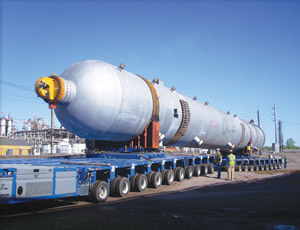There was both bad and good news for petroleum contractors this summer. The bad news was a pall of uncertainty currently shrouding petro markets as major oil-spill disasters—Gulf of Mexico rig explosions and a Michigan pipeline leak so far this year—ratcheted up scrutiny, opposition, delays and cancellations of new projects. But if there is good news for petro contractors, it is the fact that America’s monstrous thirst for oil remains unabated, and contractors know it’s only a matter of time before the carbon-based infrastructure market comes roaring back to life.

Many contractors are saying it’s already started happening.
“Clearly the market has reached bottom and is recovering now,” says Ian Anderson, president of energy and chemicals at Englewood, Colo.-based CH2M-Hill Co. “There is increased activity, and I’m optimistic going forward.” The firm is contractor on several petro projects in Alaska for undisclosed dollar values. Construction includes an oil rig, a project started earlier this year, off the coast for Italian energy company ENI as well as maintenance, gas-gathering and pipeline work for BP at several Alaska locations. “Most of our work in this sector is upstream and midstream,” says Anderson. “We have not seen any effects from the Gulf of Mexico disaster, other than an emphasis on onshore work now.”
Demand for oil is providing new onshore opportunities as offshore activity in the Gulf of Mexico is frozen under the federal moratorium on deepwater drilling. And while the Gulf region is idle, contractors such as Willbros Group Inc., one of the giants in the Gulf’s petro market, are forced to find opportunity elsewhere. The Houston-based firm won contracts this spring to construct six pump stations, underground tanks, concrete work and site fencing for a heavy- crude pipeline in Alberta, Canada, for completion by early 2011. Despite the woes in the Gulf’s petro market, “we have seen significant improvement in the Canadian market, and this project evidences our belief that the oil industry is rebounding,” says Randy Harl, Willbros president and CEO.
But even the most bullish concede that the industry is facing hard times, as project cancellations and delays are rampant. “[The market] continues to be slow and difficult,” says J.T. Grumski, senior vice president of energy and infrastructure at McLean, Va.-based SAIC. The Gulf moratorium has put pressure on upstream and downstream markets for construction, he says. Grumski points to pending federal carbon legislation and the ongoing exodus of refineries from the U.S. as additional negative factors in the current market. “Permitting [of petro projects] is very difficult in the U.S., and in the last 18 months we’ve seen the market drop by half or two-thirds,” Grumski notes. SAIC currently is engaged as contractor on three hydrocracking projects “in the $50-million to $100-million range” for an undisclosed client, says Grumski.
Valero Energy Corp. has postponed several petro projects this summer and has postponed until 2012 the expansion of a crude unit and coker at its refinery in St. Charles, La. Chevron halted work last year on a major expansion of its Richmond, Calif., refinery, and TransCanada’s proposed project for a 1,661-mile pipeline through Montana, South Dakota, Nebraska, Kansas, Oklahoma and Texas was delayed this summer following a firestorm of environmental complaints.
Meanwhile, there is activity in the alternative-energy, biofuels and liquefied natural-gas (LNG) markets. LNG projects are bubbling to the surface in the Appalachians as new rounds of exploration in West Virginia and Pennsylvania have grown new markets in the region.
Irving, Texas-based Fluor Corp. is providing design and construction services for a butanol production facility at Mountain View, Calif., for Cobalt Technologies. It is part of the contractor’s strategy to tap the burgeoning biofuels markets. “We’ve examined many different biofuels technologies and are choosing to work with those companies that we believe have the greatest potential to be commercialized economically,” says John Hopkins, group executive of business development at Fluor.
The biofuels market has opened up opportunities for contracting firms, some of which are new to the territory. For example, SAIC is contractor on a $25-million contract with the Defense Advanced Research Projects Agency to develop jet fuel from agricultural and aquacultural feedstock materials.


Post a comment to this article
Report Abusive Comment